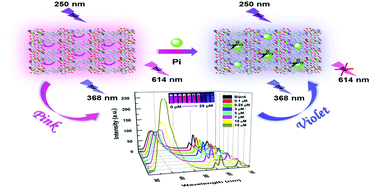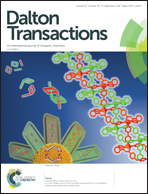Highly efficient fluorescence sensing of phosphate by dual-emissive lanthanide MOFs†
Abstract
The detection of phosphate (Pi) under physiological conditions is a very important issue in environmental and biological sciences. Herein, a unique fluorescent probe {[EuL(H2O)1.35(DMF)0.65]·1.9DMF}n (1) was prepared through the organic–inorganic hybridization between asymmetrical tricarboxylate ligands and Eu2O2 clusters under solvothermal conditions. The as-prepared sample 1 exhibited excellent fluorescence properties and could be designed as a self-calibrating fluorescent probe for sensitively and selectively detecting Pi which served as an essential substance in aquatic ecosystems and biological systems. The different responses of the two emission peaks caused by the addition of Pi resulted in a continuous fluorescence color change, which could be clearly observed with the naked eye under UV light lamp illumination at 302 nm. Typically, a good linearity existed between the ratio of dual fluorescence intensities and the Pi contents ranging from 0.1 μM to 15 μM with a low detection limit of 52 nM (S/N = 3). It is noteworthy that the prepared self-calibrating fluorescent probe displayed specific recognition towards Pi anions with satisfactory recovery ranging from 92.8% to 100.6% in water samples and biological fluids. Thus, we can envision that this work may open a new avenue for the detection of many other bioactive ions in environmental and biological samples.



 Please wait while we load your content...
Please wait while we load your content...